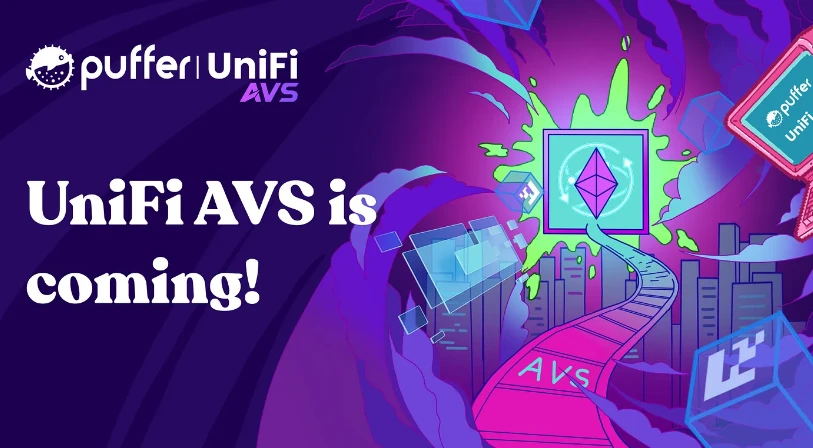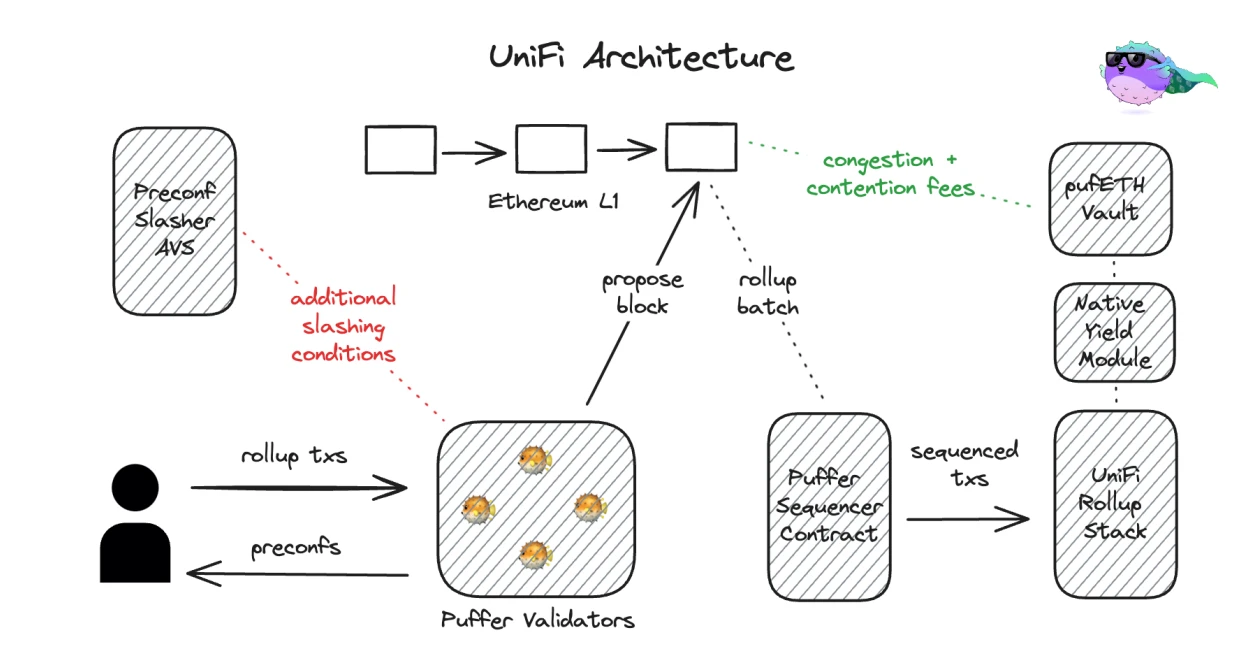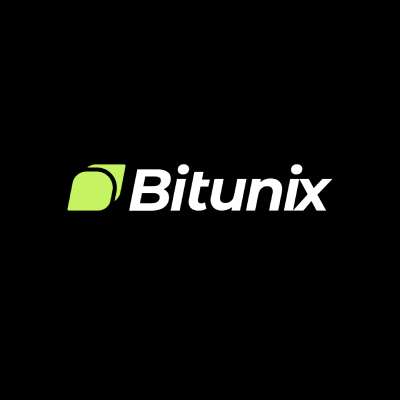Comprendre Puffer UniFi AVS : des préconfs à la prochaine décennie d'Ethereum ?
Auteur original : Puffer
Le 16 septembre, Puffer a officiellement annoncé le produit d'infrastructure de sécurité Ethereum UniFi AVS. En tant que service de vérification active (AVS) basé sur EigenLayer, il est conçu pour les défis de pré-confirmation (Preconfs) dans l'écosystème Ethereum, en particulier dans le domaine du Based Rollup, et vise à libérer tout le potentiel du Based Rollup.
La première impression que les utilisateurs ont de Puffer est peut-être qu'il s'agit d'une plate-forme de re-staking de liquidité native unique. En fait, dès le mois d'août, nous sommes passés à un fournisseur d'infrastructure décentralisée Ethereum. L'architecture du produit peut être résumée en trois chevaux : Solution basée sur Rollup Puffer UniFi, solution technologique de pré-confirmation (Preconf) UniFi AVS et produit de re-staking Puffer LRT.
Cet article vous fera découvrir en détail les services fonctionnels du produit UniFi AVS. Cependant, avant cela, il est nécessaire de passer brièvement en revue les concepts pertinents de Based Rollup. Tant que vous comprenez Based Rollup, vous pouvez également toucher du doigt l'importance et la valeur importantes d'UniFi AVS pour l'orientation future d'Ethereum.

Based Rollup : la nouvelle solution optimale pour Ethereum Rollup ?
En tant que concept officiellement proposé par Justin Drake, chercheur à la Fondation Ethereum en mars 2023, Based Rollup vise à résoudre une série de problèmes dans l'écosystème Rollup existant.
Comme nous le savons tous, après que Vitalik Buterin a publié la feuille de route Ethereum centrée sur les Rollups en 2020, l'écosystème Ethereum est entré dans l'ère des Rollups multiples. Selon des statistiques incomplètes de L2 BEAT, au moment de la rédaction de cet article, il y avait jusqu'à 39 Rollups L2. L'Optimistic Rollup et le ZK Rollup ont tous deux atténué dans une certaine mesure d'anciens problèmes tels que l'expansion d'Ethereum, mais ont également entraîné un nouveau dilemme de liquidité de plus en plus fragmentée.
Parallèlement, le séquenceur, en tant que composant central de l'architecture L2-L1, est responsable du tri et du conditionnement des transactions de L2 à L1, et joue un rôle important dans l'amélioration de l'efficacité du traitement des transactions et la réduction des coûts. Cependant, comme le L2 en cours d'exécution adopte généralement un séquenceur centralisé contrôlé par une ou plusieurs entités, il est également confronté au risque potentiel de défaillance du séquenceur ou de comportement malveillant :
En cas de problème avec le trieur, cela peut entraîner des retards de transaction, des pertes de données et même des menaces pour la sécurité des actifs. Il s'agit sans aucun doute d'un énorme danger caché pour les utilisateurs qui comptent sur L2 pour les transactions.
Qu'en est-il du trieur décentralisé ou du trieur partagé très recherché sur le marché ?
En théorie, ils peuvent effectivement éliminer le point de défaillance unique et les risques malveillants apportés par les trieurs centralisés, mais leurs mécanismes de coordination et de consensus sont relativement complexes, et il peut y avoir des problèmes de compatibilité entre différents trieurs décentralisés, ce qui rend difficile la réalisation d'un amarrage transparent. De plus, pour être réaliste, Le réseau de tri décentralisé n'a pas encore fait l'objet d'une vérification pratique réussie à grande échelle et peut encore être confronté à diverses attaques et vulnérabilités potentielles.
Par conséquent, Based Rollup suit directement le principe du rasoir d'Occam en une seule étape et supprime la conception d'un mécanisme de réseau de tri séparé : la responsabilité du tri des transactions est transférée du L2 d'origine au L1, et le nœud de vérification Ethereum L1 agit comme un proposant de bloc (proposant) pour être responsable du tri des transactions.
Cela permet non seulement d’éviter les risques liés aux trieurs centralisés, mais aussi d’exploiter pleinement le réseau de nœuds existant d’Ethereum et ses caractéristiques décentralisées, améliorant directement la sécurité au même niveau que le réseau principal d’Ethereum.
Cependant, gagner quelque chose à un endroit peut conduire à perdre quelque chose à un autre, ce qui entraîne également un autre défi : le réseau natif Based Rollup ne peut pas obtenir une confirmation rapide des transactions.
La raison est très simple. Les trieurs centralisés basés sur L2 courants peuvent trier et regrouper rapidement et obtenir une confirmation de transaction presque instantanée ; tandis que le tri des transactions de Based Rollup est la responsabilité des nœuds de vérification L1, ce qui signifie que le temps de confirmation dépend entièrement de l'intervalle de bloc du réseau principal (environ 12 secondes), et l'expérience utilisateur est bien inférieure à celle du trieur centralisé.

Basé sur Rollup, indissociable des Preconfs
Pour le dire franchement, Based Rollup est aligné sur L1 en termes de sécurité et de décentralisation, mais doit sacrifier la vitesse de confirmation des transactions. Pour la plupart des scénarios on-chain avec des attributs financiers, les conditions du marché changent rapidement. Sans parler d'une différence de 12 secondes, même une différence d'une seule seconde peut entraîner d'énormes risques et incertitudes.
Dans cette optique, nous devons ajouter un patch au Based Rollup, à savoir Preconfirmations (Preconfs en abrégé). Sa logique est également très simple, comme son nom l'indique. Imaginez :
Lorsque nous achetons des billets de train sur 12306, une fois nous sélectionnons l'itinéraire et passons la commande (transaction de signature), le système de réservation vous enverra d'abord un message de pré-confirmation, vous indiquant que le comportement d'achat du billet (correspondant à chaque transaction) a été accepté et entre dans le processus de confirmation ultérieur. À ce moment-là, nous pouvons commencer à planifier l'itinéraire, à préparer les bagages, etc. Ce n'est que lorsque le billet confirme finalement le transport et le siège (la transaction est transmise à L1) que nous avons officiellement terminé la transaction d'achat et de réservation du billet.
En bref, dans Based Rollup, la pré-confirmation signifie promettant d'inclure une transaction dans un bloc avant que la transaction ne soit formellement soumise à L1 pour confirmation. Cela équivaut à donner à l’utilisateur un signal de confirmation préliminaire pour lui faire savoir que la transaction a été acceptée et est en cours de traitement.

Cela garantit que les scénarios de transaction en chaîne qui nécessitent une rapidité d'exécution n'ont pas besoin d'attendre 12 secondes et peuvent atteindre directement des vitesses de réponse de transaction de l'ordre de la milliseconde (environ 100 millisecondes).
Cette démarche améliore non seulement considérablement la vitesse des transactions et l'expérience utilisateur, mais ne nécessite pas non plus de modifications du protocole de base d'Ethereums. Dans un sens, le Based Rollup et la pré-confirmation (Preconfs) sont comme les deux faces d'une même pièce – si le potentiel de Based Rollup doit être pleinement exploité, un service de préconfirmation sans autorisation, neutre et flexible doit être mis en œuvre.
Ce qu'il faut prendre en considération, c'est que, Dans le mécanisme de mise en œuvre spécifique, qui est responsable du tri et de la pré-confirmation des transactions et de la garantie que les engagements de pré-confirmation sont respectés ?
-
Pour la première question, la Fondation Ethereum développe un contrat d'enregistrement neutre qui ne sera affilié à aucun protocole spécifique. Il vise à fournir une base commune pour la découverte et la vérification avant confirmation, similaire au modèle de système d’enregistrement sur le marché boursier, permettant à tout proposant L1 de s’inscrire volontairement en tant que nœud de vérification de pré-confirmation ;
-
Pour la deuxième question, le mécanisme de pénalité basé sur des récompenses et des pénalités économiques peut sans aucun doute garantir que le nœud de vérification ne violera pas l'engagement de pré-confirmation, mais il est confronté à un choix en dents de scie : si une partie de l'ETH du nœud de vérification est confisquée, la logique du contrat intelligent de restaking doit être réimplémentée, ce qui est efficace en termes de capital mais également complexe ; si des garanties supplémentaires sont requises, la complexité est faible, mais l'efficacité du capital est plus faible ;
Alors, est-il possible de résoudre le problème du slashing directement en se basant sur la sécurité économique du réseau principal Ethereum avec l'aide du service EigenLayers AVS ?
Puffer UniFi AVS est basé sur cette idée. Il utilise la fonction de restaking d'EigenLayer et peut combiner le mécanisme de contrat d'enregistrement neutre de la Fondation Ethereum à l'avenir pour obtenir un scénario presque idéal :
Établir un mécanisme de participation au service de pré-confirmation sans autorisation, permettant à tout proposant L1 de s'inscrire volontairement en tant que nœud de validation de pré-confirmation, obtenant ainsi une sécurité économique directement basée sur le réseau principal Ethereum sans pénalités supplémentaires.
Puffer UniFi AVS : solution de préconfiguration pour le rollup basé
Puffer UniFi AVS comprend spécifiquement trois composants clés : Intégration EigenLayer, enregistrement en chaîne et mécanisme de découpage L'intégration d'EigenLayer confère au service de pré-confirmation Puffer UniFi AVS un avantage concurrentiel exclusif difficile à reproduire :
Basé sur l'ensemble de nœuds de vérification de re-staking de Puffers, le re-staking d'ETH peut être utilisé directement comme garantie de pré-confirmation sans avoir besoin de dépôts supplémentaires. De cette façon, une organisation, deux marques, le nœud de vérification de re-staking = nœud de service de pré-confirmation, non seulement améliore l'efficacité du capital, mais peut également rapidement créer un ensemble de nœuds de vérification de pré-confirmation avec un grand nombre de participants et une décentralisation suffisante.

Nous pouvons brièvement trier le processus de mise en œuvre spécifique de pré-confirmation de Puffer UniFi AVS.
Tout d’abord, étant donné que le nœud de vérification Puffer a été enregistré comme nœud de restaking natif sur Ethereum, lorsqu’un utilisateur soumet une transaction nécessitant une pré-confirmation, le nœud de vérification Puffer agira directement comme nœud de vérification de pré-confirmation, fournissant à l’utilisateur un engagement de pré-confirmation dans un délai d’environ 100 millisecondes, permettant à l’utilisateur de savoir rapidement que sa transaction a été reçue et sera incluse dans un futur bloc.
Après avoir fourni un service de pré-confirmation, le nœud de vérification Puffer regroupera ces transactions avec d'autres transactions et soumettra les blocs à Ethereum L1. Enfin, le contrat intelligent Puffer UniFi Puffer Sequencer Contract accepte les transactions par lots pour garantir que le statut de la transaction a été confirmé et ne peut pas être annulé.
Tout au long du processus, le mécanisme d'enregistrement et de découpage en chaîne d'UniFi AVS joue un rôle important : si le validateur ne respecte pas son engagement pré-confirmé, il sera puni, garantissant ainsi la fiabilité et la sécurité de l'ensemble du système.
Au moment de la publication, les conditions de participation à Puffer UniFi AVS sont les suivantes :
-
Propriété d'EigenPod. Les EigenPods sont un outil permettant aux validateurs Ethereum d'interagir avec EigenLayer, garantissant que le service UniFi AVS peut supprimer les validateurs qui violent les engagements de pré-confirmation ;
-
32 ETH. Étant donné que le nœud de vérification de pré-confirmation et le nœud de vérification Ethereum sont une seule organisation, deux marques, le nœud de pré-confirmation nécessite au moins 32 ETH pour participer. Cependant, la participation des opérateurs est plus flexible, qu'il s'agisse d'exécuter un nœud de vérification natif par lui-même ou de faire partie d'un produit de re-staking (LRT) ;
-
Exécutez Commit-Boost. Les opérateurs doivent exécuter le logiciel Commit-Boost en parallèle avec leurs clients validateurs pour garantir que les services de pré-confirmation sont exécutés et que la communication entre le validateur et la chaîne d'approvisionnement de pré-confirmation est gérée sans problème ;
Il convient de noter que Puffer UniFi AVS, en intégrant Commit-Boost, vise à se concentrer sur les fonctions de base telles que le mécanisme d'enregistrement et le mécanisme de réduction, en fournissant des services de pré-confirmation plus efficaces, standardisés et centrés sur la communauté tout en adhérant aux principes de base de décentralisation et d'ouverture d'Ethereum.
Qui a besoin du service Puffers UniFi AVS ?
Nous devons adopter une vision à long terme. Alors que le récit du Based Rollup continue de se développer, de nombreux projets Based Rollup vont surgir comme des champignons après la pluie, et leur demande de services de pré-confirmation est extrêmement urgente, en particulier face à des environnements de marché complexes et à des défis techniques. Ils ont besoin d'un fournisseur de services technologiques de pré-confirmation fiable pour les protéger.
Le marché a un besoin urgent d'un fournisseur de services de technologie de pré-confirmation sécurisé, c'est pourquoi Puffer UniFi AVS est essentiellement une solution universelle qui peut répondre efficacement aux besoins de toutes les parties :
-
Du côté de l'offre, reliez les nœuds de vérification de re-staking (pas seulement Puffer, mais aussi les acteurs du protocole LRT de re-staking natif tels qu'Etherfi et Renzo à l'avenir) , les soutenir pour participer à UniFi AVS afin de faire d’une pierre deux coups et d’obtenir des revenus supplémentaires en vendant leurs propres services de vérification ;
-
Du côté de la demande, l'autre extrémité fait directement face à toutes les parties du projet qui doivent créer un Based Rollup, en les aidant à obtenir des services de pré-confirmation de manière pratique via le pipeline de ressources UniFi AVS, accélérant ainsi le traitement des transactions ;
En un mot, le modèle de service de Puffer UniFi AVS est similaire à celui de la plateforme de mise en relation EigenLayers, qui vise à promouvoir l'allocation et l'utilisation optimales des ressources. Tout comme Uber et Didi, il se connecte au nœud de vérification de re-staking en tant que fournisseur et fournit des services de pré-confirmation de cumul basé sur la demande du côté de la demande via la correspondance.
Cela accélérera non seulement considérablement le processus d'innovation dans le domaine du Based Rollup et de l'écosystème Ethereum, mais créera également de nouvelles sources de revenus pour le groupe de nœuds de vérification Ethereum, apportant une nouvelle vitalité à l'ensemble de l'écosystème.
résumé
En général, Based Rollup, en tant que nouveau type de concept de Rollup que Vitalik Buterin a mentionné à plusieurs reprises récemment, est voué à jouer un rôle plus critique dans l'évolution d'Ethereum.
Par conséquent, le service de pré-confirmation indispensable à Based Rollup est destiné à devenir une infrastructure clé pour l'orientation future de l'écosystème Ethereum. Puffer UniFi AVS, en tant que solution technologique de pré-confirmation avec une conception de mécanisme innovante, est actuellement l'étape la plus critique de Based Rollup+Preconfs :
-
Pour les utilisateurs, Puffer UniFi AVS apporte une expérience de confirmation de transaction quasi instantanée, améliorant considérablement l'expérience utilisateur et jetant des bases solides pour la popularisation et l'adoption généralisée du Based Rollup ;
-
Pour les fournisseurs de services de pré-confirmation, il renforce le mécanisme de récompense et de punition grâce à des mécanismes d’enregistrement et de pénalité en chaîne, améliorant ainsi l’efficacité et la crédibilité au sein de l’écosystème ;
-
Pour les nœuds de validation L1, cela ouvre des canaux de revenus supplémentaires, augmente l'attrait de la participation à la validation des nœuds et renforce encore les incitations économiques et la légitimité du réseau principal Ethereum.
D'un point de vue plus macro, Puffer UniFi AVS a commencé avec Based Rollup, mais est plus que Based Rollup – il est étroitement lié à la vision à long terme d’Ethereum et permet une pré-confirmation rapide sans modifier le protocole de base. L’impact ne se limite pas à l’écosystème EigenLayer, mais fournit également un nouveau paradigme pour l’innovation Ethereum, apportant des avantages tangibles aux utilisateurs, aux validateurs et à l’ensemble de la communauté Ethereum. Il devrait déclencher une série de réactions en chaîne pour la croissance continue d’Ethereum et injecter de nouvelles et plus grandes possibilités.
À propos de Puffer Finance
Puffer Finance est un innovateur de premier plan dans le domaine de l'infrastructure Ethereum, se concentrant sur la prochaine génération de Rollup - Puffer UniFi, alimenté par Liquid Resttaking (LRT) et la pré-confirmation en tant qu'AVS. Avec des produits tels que le protocole de restaking natif, Puffer UniFi et UniFi AVS, Puffer s'est engagé à améliorer la décentralisation d'Ethereum. puffer.fi
Cet article provient d'Internet : Comprendre Puffer UniFi AVS : des préconfs à la prochaine décennie d'Ethereum ?
En lien : Rapport de recherche Coinbase : les pièces stables et le nouveau paysage des paiements
Introduction Actuellement, l'infrastructure mondiale de paiement est en cours de modernisation et d'amélioration, ce qui offrira aux utilisateurs des méthodes de paiement plus rapides et moins chères. Les stablecoins sont de plus en plus utilisés pour créer des systèmes de paiement cryptographiques robustes, faciliter les paiements par transfert de fonds et simplifier les transactions transfrontalières. En 2023, le volume total des transactions réglées sur le marché des stablecoins a dépassé 10,8 billions de dollars américains (10,8 billions de dollars américains) – 2,3 billions de dollars américains (10,8 billions de dollars américains) si l'on exclut les transactions non naturelles, telles que les robots ou les transactions automatisées. Sur une base ajustée, le volume des transactions a augmenté de 171 billions de dollars américains (19,9 billions de dollars américains) d'une année sur l'autre, ce qui signifie que les stablecoins rattrapent rapidement les plus grands réseaux de paiement existants. Bien que les réseaux de paiement existants bénéficient d'avantages importants en termes de liquidité et d'effets de réseau, à mesure que la concurrence s'est intensifiée, le coût moyen des paiements par transfert de fonds a diminué de plus d'un tiers au cours des 15 dernières années, selon…







